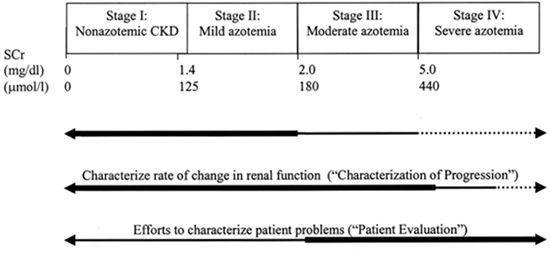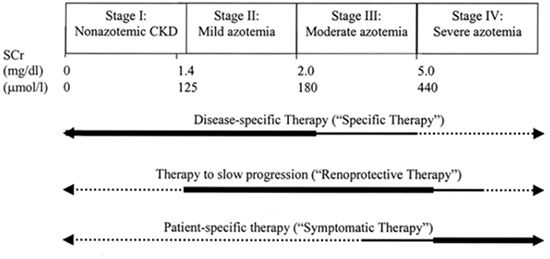Chronic Kidney Disease (CKD)
CKD in dogs and cats generally progresses along a continuum from an initial nonazotemic stage to end-stage uremia. As veterinarians, we are obligated to address the specific problems and patient needs that characterize the animal's disease, and this varies from stage to stage. The International Renal Interest Society has proposed a classification system for CKD which facilitates this staged approach to CKD in dogs (Table 1) and cats (Table 2). This classification scheme is based on the use of serum creatinine concentration to estimate degree of decline of GFR caused by the kidney disease. The IRIS proposal recognizes that the degree of azotemia in cats is not synonymous with that in dogs. This classification system employs 4 stages as Stage 1: Nonazotemic CKD disease, Stage 2: Mild renal azotemia, Stage 3: Moderate renal azotemia, and Stage 4: Severe renal azotemia.
Stage I: Nonazotemic CKD
In the initial stage of CKD, the animal is not azotemic and generally has no observable clinical signs!
Stage II: Mild Renal Azotemia
This stage of CKD occurs when there is sufficient loss of renal tissue such that azotemia is now present, usually without clinical signs. During this stage, slowing progression of the disease is an important factor. The rate of progression is often slow in cats (months to years) but erratic and more rapid in dogs (weeks to months). Therapies to delay.
Stage III: Moderate Renal Azotemia
This stage reflects the effects of further declines in GFR and increased likelihood of clinical signs of advancing CKD. Both progression and uremia are concerns in this stage.
Stage IV: Severe Renal Azotemia
Patients in stage generally have clinical signs, referred to as the uremic syndrome. Prospectively identifying and alleviating these complications is critical in this stage.
Staged Diagnostic Approach to CKD
In early CKD (Stages I and II), it is important to try to establish a diagnosis of the disease that is affecting the kidney, herein referred to as the "renal evaluation". This generally includes serum biochemistry panel, hematology, urinalysis, specific assessment of proteinuria, renal imaging studies, and ideally also includes specialized renal function tests and a renal biopsy. The goal in these early stages is to identify the renal disease that is present and to characterize its severity.
There is believed to be a final common pathway of progression of renal disease that begins during stage II or III in many animals. As the disease progresses on the pathway, the structural and functional changes observed tend to be similar across specific renal diseases.
A second important diagnostic goal is to determine the rate of progression of the disease ("Characterization of Progression"). This will vary with the disease process, species, and individual patient. This is an important task for the attending veterinarian as efforts to slow the progression of the disease depend upon an understanding of the rate of progression in the animal. Some diseases progresses very rapidly, other slowly, still others will be stable for very prolonged periods of time. Understanding the rate of progression in an individual patient will allow the judicious use of intervention.
In latter stage II and stage IV, the clinical manifestations of the uremic syndrome (i.e., biochemical and clinical abnormalities due to severe renal dysfunction) are important. It is critical that a diagnostic plan be formulated to identify these problems in their incipient phases ("Patient Evaluation"). These problems include, for example, disorders of potassium, phosphorous, calcium and acid-base homeostasis, anemia, systemic hypertension, weight loss, and gastrointestinal abnormalities.
Staged Therapeutic Approach to CKD
In the early stages of CKD, institution of treatment for any identified renal disease is a goal ("Specific Therapy"). If the identity of the disease is known (e.g., pyelonephritis), this therapy may be the critical (e.g., appropriate antibiotic therapy).
Further therapeutic concerns include therapy designed to slow the progression of renal disease ("Renoprotective Therapy"), such as dietary modification (e.g., dietary omega-3 PUFA supplementation) or the use of antihypertensive agents with specific intrarenal effects (e.g., ACE inhibitors).
In the latter stages, some of these complicating factors, such as electrolyte disorders and anemia are readily identified by laboratory assessment of the patient and should be treated on an individualized basis ("Symptomatic Therapy").
Table 1. IRIS* classification of canine chronic kidney disease (CKD).
|
Stage |
I |
II |
III |
IV |
|
|
Non-azotemic CKD |
Mild renal azotemic |
Moderate renal azotemia |
Severe renal azotemia |
|
Creatinine: |
|
(mmol/L) |
< 125 |
125 to 180 |
181 to 440 |
>440 |
|
(mg/dl) |
<1.4 |
1.4-2.0 |
2.1 to 5.0 |
>5.0 |
*IRIS: International Renal Interest Society
Table 2. IRIS* classification of feline chronic kidney disease (CKD).
|
Stage |
I |
II |
III |
IV |
|
|
Non-azotemic CKD |
Mild renal azotemic |
Moderate renal azotemia |
Severe renal azotemia |
|
Creatinine: |
|
(mmol/L) |
< 140 |
140 to 250 |
251 to 440 |
>440 |
|
(mg/dl) |
<1.6 |
1.6-2.8 |
2.9 to 5.0 |
>5.0 |
*IRIS: International Renal Interest Society
| Figure 1. | 
Diagnostic focus in different stages of chronic kidney disease (CKD) |
|
| |
| Figure 2. | 
Therapeutic focus in different stages of chronic kidney disease (CKD) |
|
| |
References
1. Brown SA, Barsanti J, Finco DR. Pathophysiology and management of progressive renal disease in dogs. Brit Vet J 1996; 152: 1-24.
2. Brown SA: Evaluation of chronic renal disease: A staged approach. Compend on Contin Educ 1999; 21: 752-763.
3. Finco DR, Brown SA, Brown C, Crowell W, Copper T, Barsanti J. Progression of chronic renal disease in the dog. J Vet Int Med 1999; 13: 516-528.